

Mind Mapping. Visible Thinking. Core Routines The core routines are a set of seven or so routines that target different types of thinking from across the modules.
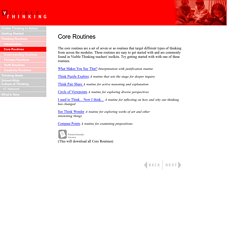
These routines are easy to get started with and are commonly found in Visible Thinking teachers' toolkits. Try getting started with with one of these routines. What Makes You Say That? Interpretation with justification routine Think Puzzle Explore A routine that sets the stage for deeper inquiry. 100 Reasons to Mind Map. 100 examples of how you can use mindmapping whether completely new to mind maps or a seasoned pro.
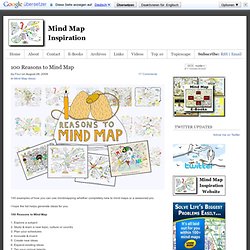
I hope the list helps generate ideas for you. 100 Reasons to Mind Map 1. Explore a subject 2. Study & learn a new topic, culture or country 3. Mind Mapping Benefits. Clive Lewis, the author of this briefing, has used Mind Maps for over 25 years and has trained thousands of people in how to gain dramatic benefits from this uniquely versatile technique.

Businesses and other organisations have many needs that can be satisfied by properly constructed Mind Maps. The key is to ensure that Mind Maps are used effectively. To paraphrase the age-old truth: "No-one needs Mind Maps; they need what Mind Maps can do for them! " In order to be successful in the long term, people and the organisations they work for need to constantly develop their effectiveness and their efficiency.
Read some real Mind Map user stories As someone who has used Mind Maps throughout my adult life, I am sometimes guilty of being a little fanatical about how they can transform people’s working and learning. How to teach mind mapping and how to make a mind map. How to use a Concept Map to organize and comprehend information. Used as a learning and teaching technique, concept mapping visually illustrates the relationships between concepts and ideas.
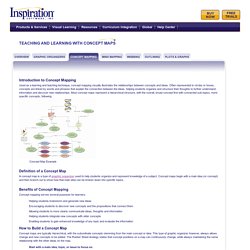
Often represented in circles or boxes, concepts are linked by words and phrases that explain the connection between the ideas, helping students organize and structure their thoughts to further understand information and discover new relationships. Most concept maps represent a hierarchical structure, with the overall, broad concept first with connected sub-topics, more specific concepts, following. About Concept Maps & Software. Introduction Concept maps are graphical tools for organizing and representing knowledge.
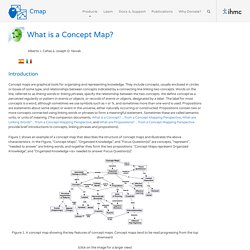
They include concepts, usually enclosed in circles or boxes of some type, and relationships between concepts indicated by a connecting line linking two concepts. Words on the line, referred to as linking words or linking phrases, specify the relationship between the two concepts. We define concept as a perceived regularity or pattern in events or objects, or records of events or objects, designated by a label . The label for most concepts is a word, although sometimes we use symbols such as + or %, and sometimes more than one word is used.
Figure 1 shows an example of a concept map that describes the structure of concept maps and illustrates the above characteristics. Figure 1. (click on the image for a larger view) Characteristics of Concept Maps Concept maps have specific characteristics that distinguish them from other knowledge representation tools. Propositional Structure Hierarchical Structure. WiseMapping - Visual Thinking Evolution. Online Mind Mapping and Brainstorming - MindMeister. Online Mind Mapping and Brainstorming app - SpiderScribe. Using Brainwriting For Rapid Idea Generation. Advertisement When a group wants to generate ideas for a new product or to solve a problem, you will usually hear the clarion call, “Let’s brainstorm!”
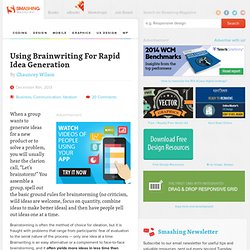
You assemble a group, spell out the basic ground rules for brainstorming (no criticism, wild ideas are welcome, focus on quantity, combine ideas to make better ideas) and then have people yell out ideas one at a time. Brainstorming is often the method of choice for ideation, but it is fraught with problems that range from participants’ fear of evaluation to the serial nature of the process — only one idea at a time. Brainwriting is an easy alternative or a complement to face-to-face brainstorming, and it often yields more ideas in less time than traditional group brainstorming. What Is Brainwriting? When I teach my graduate course in “Prototyping and Interaction Design,” I start with a class on ways to generate ideas. Brainwriting is simple. When To Use Brainwriting Brainwriting can be used in the following situations: Five Best Mind Mapping Tools. Five Best Mind Mapping Tools. Mind Mapping. Mind Mapping Software, Brainstorming, GTD and Knowledgebase Software.
Make a Mind Map to Keep on Top of Everything in Your Life. How to Build New Habits with Mind Maps and Mindmapping. Recently I had the opportunity to read a fantastic book on habits and how they really work backed with some scientific research.

What really stood out how the author was able to break down habits into different components that would make it much easier to adapt new habits and change old ones. With help of mind maps building new habits has become even easier. Here’s how. Quick Summary Each habit consists of a cue, routine and a reward.Mind maps support you in planning your habit and effectively overseeing it.Each mind map will have a branch for each habit component.Specify your plan of action and details in your mind map. Habits 101: The Habit Loop In the book The Power of Habit, author Charles Duhigg writes how each habit can be broken down into different parts and I’m going to borrow his framework for this post. CueRoutineReward This is the habit loop. The habit loop. Mind Mapping & Diagrams. Create a Change Map So You Don't Forget to Adapt to New Circumstances. Mind Mapping. 99 Mind Mapping Resources, Tools, and Tips.
So, there you are staring at that black sheet of paper again.

Or perhaps it's a black Word document on your computer screen. Whichever it may be, it's obvious you're about to take notes for that big essay assignment or group project, and you're not too excited about getting started! That's where a different kind of note taking comes in to play, one that is actually fun to do and will also help you to understand your notes better. It's a technique called mind mapping, and is based around a strong visual method of taking notes. Whether your using colorful markers and paper or using state-of-the-art computer software, you'll find using mind maps are a much more interesting way to take notes than you ever have in the past! Free Software Free Mind - the premier java-based mind mapping software known for its quick, one-click "fold/unfold" and "follow link" operations.
Wisemapping - "Visual Thinking Evolution", offering free web based mind maps you can share anywhere on the web. Resources Books.